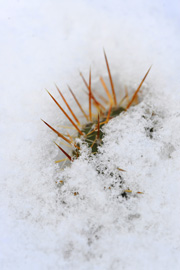Exotic plant in winter? Take it to the house or to the greenhouse. That's what we Central Europeans think. But that's not always true.
Some cactus species thrive even under very rough conditions. For example, the night temperatures in the South American Cordilleras drop to -40 °C.
Different species of Opuntia, Gymnocalycium, Echinocereus and even Escobaria have adapted perfectly to these living conditions. During the heavy rains in spring, they literally pump themselves full of water and nutrients, which they then consume over the hot summer. By winter, the cells have released most of the stored water again, only the cell sap as a storage medium is still contained. So the frost won't harm them.
Just leave the plants to themselves in winter. They do them no favors when they stand warm or are poured. The bear doesn't need any food during hibernation either. The care of the robust plants during the growing season is very simple; just follow the instructions below.
You will find comprehensive information in the handbook ?Winter-hard cacti? by Fritz Kümmel and Konrad Klügling - now in its third edition.
How to put your plants in the right light
If you want to plant in a rock garden, you will find the right plants here.
Almost all of these plants hibernate outdoors without cover. With a sunny southern slope, they create the best conditions for a rich flowering. When planning a rock garden, care should always be taken to provide the substructure with plenty of gravel for good drainage. Accumulating wetness can cause the cacti to rot.
A wall in the "back" of the planting site rounds off the rock garden. On the one hand, it protects against the cold and damp northwest winds. It reflects the sun's rays, stores the heat and releases it slowly overnight.
Quarrystones of different sizes integrated into the bed are not only very decorative, but also have a positive effect on the heat and water balance in their surroundings. They should be placed neatly before planting in order to create a natural overall impression. Cacti feel particularly comfortable in the crevices between the stones. The matching plants that make your bed look particularly natural can be found here.
All hardy?
Have you discovered that even hardy Epithelantha exist?
In this overview we have compiled even more exciting species in which you will find hardy species. Some old acquaintances, but also some surprises are certainly included:
Acanthocalycium, Agave, Aloe, Arenaria, Berkleya, Calandrinia, Carex, Chiastophyllum, Cistus, Coryphantha, Crassula, Cyclamen, Delosperma, Dionea, Dodecatheon, Dudleya, Echinocereus, Echinofossulocactus, Epithelantha, Escobaria, Euphorbia, Ferocactus, Festuca, Glandulicactus, Gymnocalycium, Hamatocactus, Hesperaloe, Hesperoyucca, Homalocephala, Iris, Jovibarba, Koeleria, Lewisia, Luzula, Maihuenia (see Opuntia), Mammillaria, Mirabilis, Moltkia, Navajoa, Nolina, Notocactus, Olsynium, Opuntia, Orostachys, Oxalis, Parodia, Pediocactus, Petrophytum, Plantago, Pyrrhocoma, Raoulia, Rhodiola, Rosularia, Santolina, Sarracenia, Saxifraga, Sclerocactus, Sedum, Sempervivella, Sempervivum, Tanacetum, Titanopsis, Townsendia, Trichocereus, Trillium, Wigginsia, Yucca, Zauschneria. For beginners and larger surfaces there are the favorable assortments.
(not all genera mentioned are available at any time)
temperature zones
What temperatures is a plant exposed to at home? (you will find the markings by the name of the plant)
*1 below -20 °C
*2 to -20 °C
*3 to -15 °C
*4 to 0°C in mild areas
^ Rain cover recommended
These figures are recommendations - the reference temperatures refer to the climate at home, the temperatures are usually compensated by extreme day temperatures. We do not guarantee that the plants will survive the temperatures mentioned at each location. With careful care, good growth can certainly be achieved even in extreme temperatures.
 Deutsch
Deutsch
 English
English


